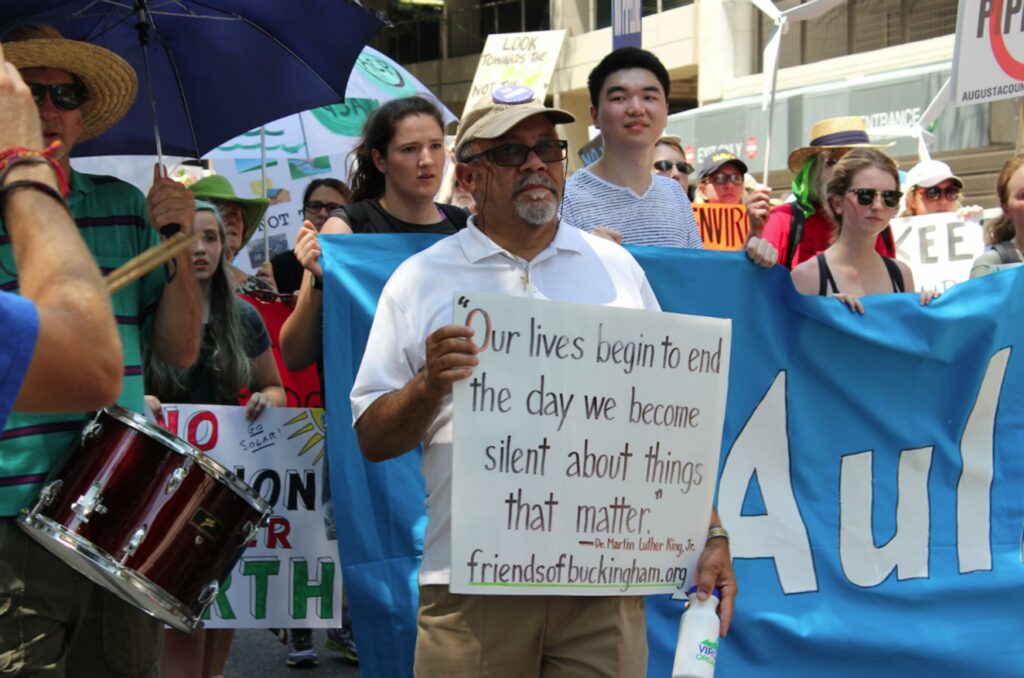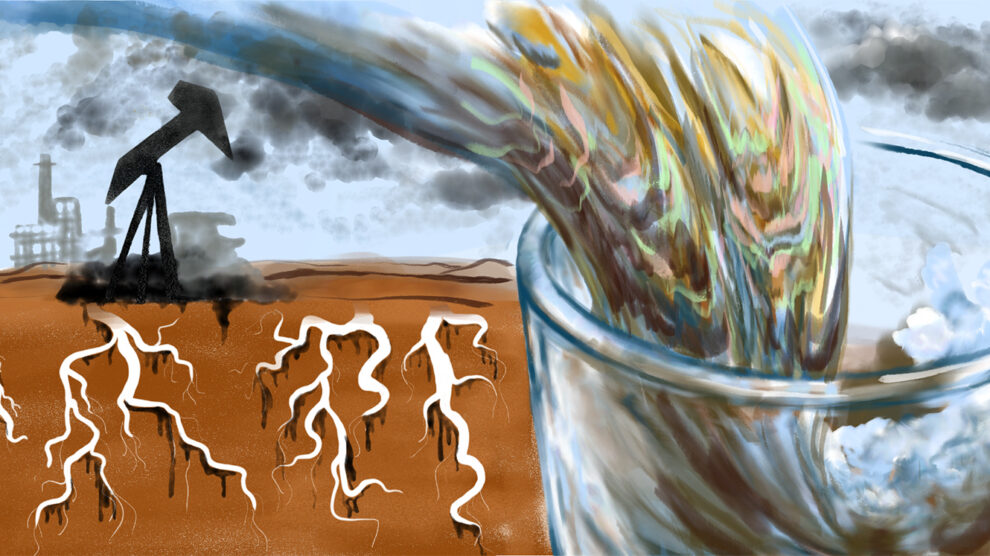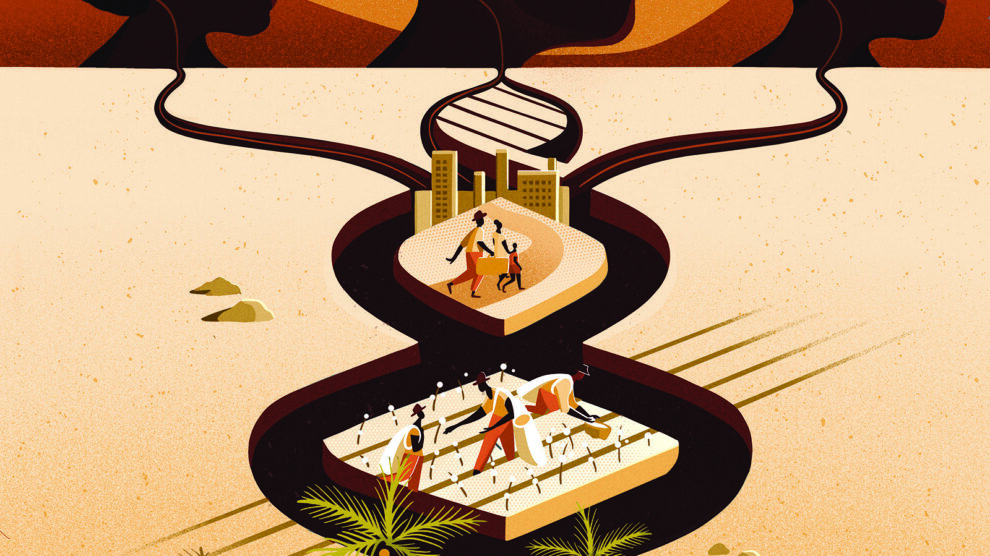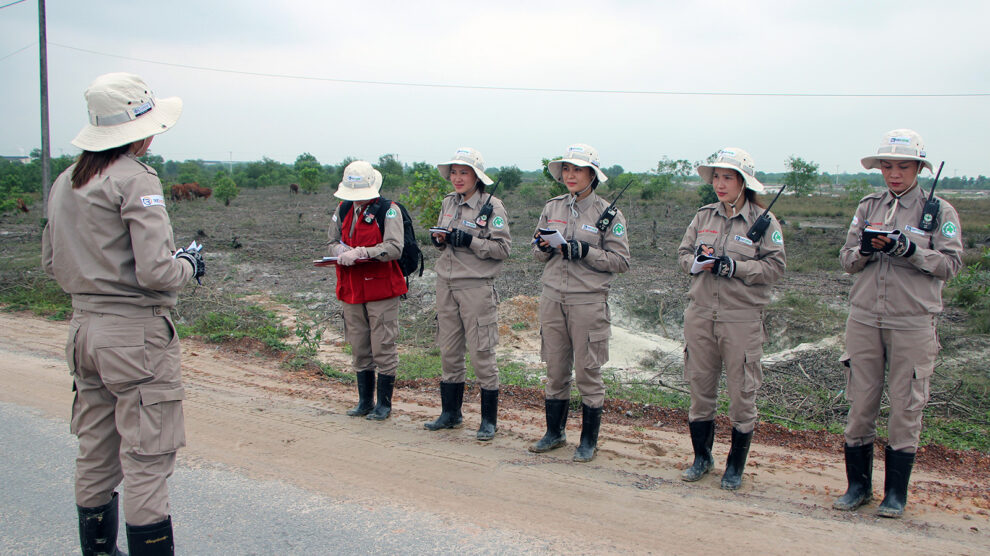Resisting Technocratic Erasure
Environmental Racism, Racial Capitalism, and the Fight Against the Union Hill Compressor Station
By Travis L. Williams
Volume 24, Number 1, Racial Capitalism
July 19, 2021
Union Hill is a historic Black freedmen settlement established by formerly enslaved Black people at the end of the Civil War in rural Buckingham County, Virginia. In 2013, Dominion Energy submitted an application to construct a natural gas compressor station in the immediate vicinity of this community to help move natural gas down the then-proposed Atlantic Coast Pipeline.1 In their application, Dominion refused to recognize the existence of the Union Hill Black freedman community and the potential impacts of a 57,000 horsepower compressor station that would spew toxic pollutants twenty-four hours a day onto this community. Unfortunately, the state of Virginia also ignored the existential integrity and potential risk burden of a Black rural community by validating the exploitive misuse of census data by corporate actors applying for the compressor station permit. This further set the stage for the permit applicants to potentially avoid accountability for environmental justice concerns surrounding their site choice for the facility.
Local community organizers, part of the Friends of Buckingham coalition that opposed the compressor station, responded by using Community Participatory Action Research (CPAR) methods to document the demographics of Union Hill.2 The coalition found that there were many households, most of them African-American and many descended from Black freedmen, within the vicinity of the proposed site. This qualitative community study became particularly relevant when the Fourth Circuit Court of Appeals recognized the data included in the study as valuable in its determination that the permit applicants had failed to do a proper environmental justice review.
The theory of racial capitalism conceptualizes modern industrial capitalism as a system of domination based on the creation and exploitation of racial difference in the service of capital. A similar system of exploitation is observed within environmental racism, explained by environmental sociologist Robert Bullard as
“the racial discrimination in environmental policymaking, the enforcement of regulations and laws, the deliberate targeting of communities of color for toxic waste facilities, the official sanctioning of the life-threatening presence of poisons and pollutants in our communities, and the history of excluding people of color from leadership of the ecology movements.”3
Thus, the struggle for environmental justice is inherently a struggle against racial capitalism, as exemplified by the successful grassroots opposition against the proposed natural gas compressor station in the Black freedmen community of Union Hill. This case provides useful insights into the dynamics of environmental racism, the misuse of technical data by powerful state and corporate interests, and the use of community participatory action research methods by environmental justice coalitions under conditions of racial capitalism.
Technocratic Environmental Racism in the Risk Society: The Erasure of Union Hill
The compressor station was part of the proposed six hundred mile long Atlantic Coast Pipeline (ACP), a $7 billion project led by Dominion Energy that would have shipped liquified natural gas (LNG) from West Virginia through Virginia and down into North Carolina. It was slated to connect with coastal ports along the way, sending the LNG overseas to markets in Japan and India. Pipelines require compressor stations to compress the fuel and maintain pressure as it is transported through the pipeline. These are notoriously polluting, and the Buckingham compressor station slated for Union Hill would be no different. Designed to be one of the most powerful compressor stations in operation, it would emit many pollutants, including known human carcinogens, according to data submitted by the company. The long distances that the ACP must transport gas require it to use the highest levels of legally permissible pressure at compressor stations, which increases the potential for fires, explosions, and other harmful accidents.
Additionally, the predicted impact of the compressor station on nearby air quality alone is enormous. In their air permit application to the Virginia Department of Environmental Quality (DEQ) Air Pollution Control Board, ACP requested permission to emit the following volumes of air pollutants annually: 43.4 tons of nitrogen oxide, 51.6 tons of carbon monoxide, 7.6 tons of volatile organic compounds, 43.2 tons of particulate matter, 8.3 tons of sulfur dioxide, 295,686 tons of carbon dioxide, 70.9 tons of methane, 5.3 tons of additional hazardous air pollutants.4 These are dangerous toxic chemicals that threaten human health, especially the health of vulnerable communities like Union Hill where the population is disproportionately elderly and living with preexisting medical conditions. One particularly acute issue of concern for the Union Hill community was compressor station “blowdowns,” which occur when the pipeline gas is vented from the system for routine maintenance or during emergencies. These events are associated with sharp spikes in pollutant emissions. In their air permit application, Dominion requested permission to conduct one hundred blowdown events per year.
Thus, the struggle for environmental justice is inherently a struggle against racial capitalism, as exemplified by the successful grassroots opposition against the proposed natural gas compressor station in the Black freedmen community of Union Hill.
The Union Hill compressor station permit applicants, led by Dominion Energy, completed basic social and environmental impact surveys as part of the application process. The ACP 2015 application to Federal Energy Regulatory Commission (FERC) used a measurement of average person per square mile for the entire county of Buckingham (29.6 people/sq mile), which rendered invisible the actual existing demography of their preferred site for the ACP compressor station. The initial analysis that Dominion submitted to the FERC also stated that there would be no cultural resources impacted by the proposed compressor station. Accordingly, Dominion claimed that there was no need to conduct an Environmental Justice (EJ) analysis. It was these specific and ungrounded claims, the claim that no minority communities would be disproportionately impacted and the claim that there were no cultural resources impacted, that fueled the effort to conduct a community qualitative study to prevent the technocratic erasure of Union Hill. Despite Dominion’s claims, the existing data already indicated that the area within the immediate vicinity of the proposed compressor station had minority and poverty percentage attributes that made it eligible for EJ considerations. An EJ analysis serves to “determine whether a project will have a disproportionately adverse effect on minority and low income populations.”5
Around the same time, in response to Dominion and the state of Virginia’s attempts to erase Union Hill, a coalition of local residents, community organizers, nonprofit organizations, college students, and environmental activists from across Virginia took the lead on documenting Union Hill. Led by local anthropologist Lakshmi Fjord, part of the first cohort of yogis to establish Yogaville in Buckingham County and a contemporary visiting scholar at University of Virginia, the grassroots effort led to a door-to door qualitative community health study. Fjord and other Yogaville community leaders were first approached by Paul Wilson, pastor at two local Southern Baptist churches within the vicinity of the compressor station site. The two groups joined forces and were later joined by an independent group called Friends of Buckingham, led by Chad Oba, to form the coalition that led the Union Hill struggle.

This community survey was part of an effort to document Union Hill as a historic Black freedmen community at risk from the proposed compressor station. However, rather than consulting this community health survey, both Dominion and the state of Virginia sought out their own sources of data to include in the permit application. The Virginia DEQ used the EPA’s EJSCREEN data, based on census tract records, to argue that the area around the proposed location for the compressor station did not meet criteria for an EJ analysis.6 But the EPA actually warns against relying on aggregate census tract record analysis for conducting EJ analyses, due to the potential of census track records to dilute unevenly distributed populations, such as clusters of homes located in otherwise sparsely populated rural areas. They also explicitly recommend that initial EJSCREEN results be “supplemented with additional information and local knowledge whenever appropriate, for a more complete picture of a location.” Dominion Energy failed to take these recommended steps. Instead, in their effort to calm public concern about their incomplete data, Dominion obtained additional data generated using Environmental Systems Research Institute (ESRI) mapping, and used it to disqualify previously submitted data to FERC (and the EJ-relevant implications of said data), thus dismissing any further EJ analysis as unwarranted. They were able to garner academic support and validation for their misleading ESRI data analysis from the L. Douglas Wilder School of Government Public Affairs at Virginia Commonwealth University.7 However, there was much outcry by people familiar with Union Hill because the reported data did not even acknowledge the existence of the Black freedman community located in the immediate vicinity of the proposed compressor station, effectively erasing this community.
Being heard requires increasingly complicated technical information and know-how that is often not equally accessible.
The entire process highlights how, in our capitalist, neoliberal democracy, politics are deeply embedded in technocratic decision-making procedures. Being heard requires increasingly complicated technical information and know-how that is often not equally accessible.
Resisting the Erasure of Union Hill with Community Participatory Action Research
Lakshmi Fjord framed the organized efforts as a struggle against environmental racism. In an effort to resist the demographic erasure of Union Hill, this coalition conducted a door-to-door household qualitative study in the Union Hill community using a Community Participatory Action Research (CPAR) approach that followed the leadership of local community members in the systematic collection of household data. Dr. Fjord worked with college students from University of Virginia and organized the basic research framework for the study; the data-gathering effort was led by local community resident experts John Laury, Ruby Laury, and Marie Gillespie. The study was designed to “uncover key unknown demographic data, health conditions, use of land for agricultural and domestic food production, and family heritage.”8 This research effort emphasized collective inquiry and history and utilized community-driven ethnographic methods that put data-gathering leadership in the hands of local community resident experts.
Ground-Truthing
The community research coalition went to great lengths to ensure the robustness of the study. A particularly useful research method employed by the community-led data gathering strategy is known as ground-truthing. Ground-truthing involves the gathering of research data based on direct observation rather than through inference. Volunteers from the community used this strategy to correct the 20 percent of the property data that was incorrectly defined on the map, inaccuracies that had gone unnoticed or unaddressed by the Commissioner of Revenue’s office.
This kind of contact with the community proved critical to the coalition’s success, as described in the final report:
“The research tools were only effective because they were refined in collaborative dialogue with Union Hill residents during field-testing in workshops at Union Hill Baptist Church and Union Grove Missionary Baptist Church, the two historic black churches in the community. The draft components questionnaire I wrote went through many revisions when long-time residents tried them out on each other. The questionnaire would have been far less effective a means of data gathering without their fine-grained analyses integrated into better ways of going about asking and talking about what we needed to know . . . Even after our first foray on the ground, we made necessary changes based on participants’ honest feedback.”9
The most important information documented was the demographic profile of Union Hill, as this was the attribute explicitly contested in legal permit proceedings. The Friends of Buckingham qualitative household study, a shining example of community science, got a seventy-seven percent response rate.10 In an interview with Southern Environmental Law Center, Fjord described how racialized patterns of traditional information gathering would not have been effective for documenting Union Hill: “White norms about checking off boxes in surveys and giving out information would fail to uncover the evidence we needed to prove environmental injustice.”11 Fjord gives an example how local community knowledge enhances the research process in ways that would not be apparent to outsiders:
“. . . you don’t just drive up to someone’s house in Buckingham and immediately knock on the door. There’s an understanding that one should drive up, park, stand by the car, and wait until someone notices you’re there. If they don’t, you stand back from the door and when someone answers, you immediately identify yourself with your kinship ties or allyship to the community.”12
These valuable insights were garnered from local community resident experts, and are a key reason why the response rate for the household study was so robust. Contrary to Dominion’s reported numbers, the Friends of Buckingham coalition found that there were ninety-nine households within a mile of the proposed compressor station site and that approximately 83 percent of them were minorities. The community survey also revealed that approximately one-third of these residents could trace their ancestry to the Black freedmen who had settled the area at the end of the Civil War.13
Meanwhile there were many solidarity gatherings, rallies, marches, and demonstrations against the compressor station. The movement grew exponentially as it became nationally recognized and was covered by a wide variety of media. Yet while Fjord’s community study data was included among the attachments on the Virginia DEQ website for the air permit, it was not meaningfully incorporated into the initial decision to grant the permit for the compressor station. The Virginia Environmental Justice Advisory Council organized by Virginia’s governor Ralph Northam explicitly recommended that the compressor station permit be suspended until an adequate EJ analysis had been conducted. However, Governor Northam, whose administration had worked closely with Dominion throughout the process, ignored this advice.14 The state of Virginia continued to downplay the environmental concerns of Union Hill residents and, in particular, their claims of environmental racism, instead choosing to rely on Dominion’s faulty data.
Contrary to Dominion’s reported numbers, the Friends of Buckingham coalition found that there were ninety-nine households within a mile of the proposed compressor station site and that approximately 83 percent of them were minorities.
How Community-Driven Research Helped Stop the Buckingham Compressor Station
Friends of Buckingham and the Chesapeake Bay Foundation brought suit against the Air Pollution Control Board and the Virginia DEQ for failure of duties regarding the proposed compressor station. The Fourth Circuit Court of Appeals ultimately overturned the air permit for the proposed compressor station in Union Hill, citing the Air Pollution Control Board’s failure to conduct a proper environmental justice site review, the exclusion of relevant demographic data generated by a local community study, and failure to consider the impact of gas turbines on African-American residents with specific kinds of pre-existing health problems. Significantly, the ruling referenced the community-generated data about the history and demography of Union Hill. It was also during this court case that, after years of community organizing, the community of Union Hill was legally recognized as a unique and directly impacted community. Union Hill became the first historic Black freedmen settlement to receive nomination for historic landmark status in the state of Virginia.
In February 2021, the Virginia Department of Historic Resources also recognized the Union Hill community health study, explicitly noting its “groundbreaking research methodology.”15 The Department of Historic Resources expressed their hope that other freedmen settlements in Virginia and other states would use the methods of the Union Hill study as a template for historical documentation and preservation.
Accountability, Technocracy, and Racial Capitalism
In the 1990s, “we speak for ourselves” became a popular slogan in the EJ movement. The slogan refers to the idea that those most directly impacted by environmental racism and injustice are the most important voices of authority in the struggle for environmental justice. The CPAR methods employed in the Buckingham community study and larger EJ movement that arose in the context of resistance to the Buckingham compressor station provide a great example of what amplifying community voices against toxic destructive industrial assault looks like. The methods used in the Buckingham community study have already been recognized as groundbreaking by the Virginia Department of Historic Places and provide a strong model for CPAR. However, while the triumph of the Friends of Buckingham coalition is inspiring and very much deserving of applause and celebration, it remains unclear whether the same approach can be replicated verbatim elsewhere in other communities struggling against powerful state and corporate interests. Additionally, we should be striving for a society where we do not need to defend ourselves from constant state-sanctioned corporate industrial assault on land, heritage, health, and identity. We should not have to be reduced to a combative state of total legal and technical warfare all the time just to live with dignity and basic human protections. There are still many other communities of color sacrificed for or currently struggling against toxic industrial facilities who have been assaulted by toxic industrial development and did not ever see justice. This is often due to lack of access to resources needed to fight powerful state and corporate interests.
Nonetheless, the Union Hill case highlights the importance of challenging technocratic authority. Racial capitalism exploits and dehumanizes nonwhite bodies in the service of capital. It conceives the State as an active social agent with vested political economic interests and orientations that align with white supremacy. Technical data and expertise are strategically exploited as political resources by powerful state and corporate interests in environmental decision-making in ways that reinforce racial capitalism. But the same data and expertise can also be mobilized in the form of “citizen science” by frontline communities resisting state-sanctioned racialized ecological violence. Such challenges to authority, aligned with the long-term goal of ecological justice and the dismantling of racial capitalism, can be implemented to fight back against the predatory targeting and exploitation of Black and Brown communities by powerful state and corporate interests.
About the Author
Travis L. Williams, PhD, received his doctorate in Sociology at the University of California, Santa Cruz and currently works as a Teaching Faculty instructor in the Department of Sociology at Virginia Commonwealth University where he teaches classes on environmental sociology, race, ethnicity and racism, and social movements. In addition to teaching sociology, he is active in his local community of Richmond, Virginia where he is part of the Virginia Environmental Justice Collaborative. Twitter: @broccoli_funk. Facebook: travislwilliamz Instagram: @broccoli_funk.
References
- Erik Ortiz, “How Money Stokes Divide of Historic Black Community in Virginia Pipeline Battle,” NBC News, December 7, 2018.
- The survey was initially designed to account for much more than demographic data, but demographic data became most relevant due to the permit parameters.
- Robert Bullard, Dumping in Dixie: Race, Class, and Environmental Quality (Boulder, CO: Westview, 1990), 278.
- Advisory Council on Environmental Justice Letter to Gov. Northam, Re: Environmental Justice Review of Virginia’s Gas Infrastructure, August 16, 2018, https://www.virginiamercury.com/wp-content/uploads/2018/09/ACEJ_LETTER.pdf.
- Friends of Buckingham v. State Air Pollution Control Board, No. 19-1152 (4th Cir. 2020).
- “Limitations and Caveats in Using EJSCREEN,” EJSCREEN: Environmental Justice Screening and Mapping Tool, United States Environmental Protection Agency, last updated June 9, 2015.
- Stephen Metts, “Dominion Energy and Environmental Racism: A Case Study in How to Lie with Maps,” Medium, https://stephen-metts.medium.com/dominion-energy-environmental-racism-a-case-study-in-how-to-lie-with-maps-9d7b54d65003 January 7, 2019.
- Lakshmi Fjord, 2018, “Union Hill Community Household Study Site and Methods Report A Community Participatory Action Research Project Part II: Households: Demographics, Health, Land Use, Family Heritage,” Submitted to Virginia Department of Environmental Quality, http://www.friendsofbuckinghamva.org/friends/wp-content/uploads/2018/12/Fjord-Union-Hill-Community-Household-Study-12-17-18-Lakshmi-Fjord.pdf; Fjord had already conducted a previous historic study of this area in May 2016 to successfully get it listed on Preservation Virginia’s “Most Endangered Historic Place in Virginia” list, on account of its uniquely valuable history of Black freedmen and the formerly enslaved.
- Fjord, “Union Hill Community Household Study Site and Methods Report,” 13.
- A response rate of 60 percent or higher is considered strong by social science survey standards. Jack E. Fincham, “Response Rates and Responsiveness for Surveys, Standards, and the Journal,” American Journal of Pharmaceutical Education (2008): 72, no. 2.
- “Union Hill Makes History Again,” Southern Environmental Law Center, February 1, 2021, https://www.southernenvironment.org/news-and-press/news-feed/union-hill-makes-historyagain.
- “Union Hill Makes History Again.”
- Fjord, “Union Hill Community Household Study Site and Methods Report,” 16.
- Friend of Buckingham v. State Air Pollution Control Board.
- “Union Hill Makes History Again.”





